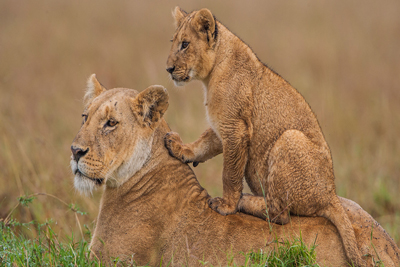
Located in southwest Kenya and bordering the Serengeti National Park in Tanzania to the south, Masai Mara National Reserve is a vast scenic expanse of gently rolling African savannah plains and is one of the most famous and important wildlife conservation and wilderness areas in Africa, renowned for its exceptional populations of lion, leopard, Cheetah and African bush elephant. Stretching across an area of 1510 sq km (580 sq miles) and representing the northernmost portion of the Mara-Serengeti ecosystem, it is named after the Maasai tribe, the ancestral inhabitants of the area, who migrated to the area from the Nile Basin, added with their description of the area in their language Mara, meaning spotted, referring to ubiquitous flat topped trees, shrubs and bushes that dot the landscape.
Regarded as one of the Seven Wonders of Africa because of hosting the Great Migration, the Masai Mara National Reserve is also considered one of the ten Wonders of the World.

Originally established in 1961 as a wildlife sanctuary, Masai Mara National Reserve is a semi-arid climatic zone with two distinct rainy seasons, which are locally named the long rains, lasting approximately six to eight weeks in April and May and the short rains that occur in November and December and last about four weeks.
It contains the Sand River, Talek River and the Mara River, which are the primary rivers draining the reserve and the area is divided into two main areas, the inner portion featuring the pristine wilderness and the outer portion used for the grazing of cattle of the Masai people. While shrubs and trees fringe most drainage lines and cover hill slopes and hilltops, the terrain of the reserve is primarily open grassland with seasonal rivulets and the southeast region houses numerous clusters of the distinctive acacia trees. However, its eastern regions are most visited by tourists as its easternmost border is only 139.2 miles (224 km) from Nairobi.


The Masai Mara National Reserve has a magnificent collection of wildlife consisting of not only all the members of the Big Five, but also the Big Nine, completing the list with the African lion, African leopard, African bush elephant, African buffalo, black and white rhinos, as well as giraffe, zebra, cheetah and hippo. Although lions are the most dominant and are found in large numbers in the reserved area, spotted hyenas are also another abundant carnivore that often competes with lions for food. Leopards are found anywhere in the reserve, especially the areas containing the trees where they climb up to take a rest or to escape. However, the east African cheetahs are mainly found in high numbers on the open savanna, hunting gazelles, a type of antelope, popularly known as the gnu.
It is interesting to note that the Masai Mara is the only protected area in Kenya with an indigenous black rhino population due to its huge area, unaffected by translocations, which often refer to genetics, when part of a chromosome is transferred to another chromosome. The African wild dogs roam around the area in groups and travel far distances throughout the plains, making it hard to track them. However, their numbers have dwindled due to the widespread transmission of diseases like canine distemper and food shortage, due to the keen competition they face with lions for food. The other smaller carnivores that usually don’t compete with the others include African Wolves, black-backed Jackals, a type of medium-sizes wild cat called Caracals, bat-eared Foxes, several Mongoose and others.

Apart from the predators, the dominant inhabitants of the Masai Mara National Reserve are the Wildebeest or the Gnu, whose population is estimated in the millions. The other antelopes of the area include Grant’s gazelles, a relatively large species with a beige-orange on the back with a white belly, known as swala granti in the Swahili language; Impala or Rooibok, a medium-sizes antelope; Duiker, a small to medium-sized brown antelope; and Coke's hartebeest, a large migratory antelope with narrow face with pointed ears. Even, the large Roan antelope with white eyebrows and cheeks and black faces, and the nocturnal bat-eared fox, which are rarely present elsewhere in Kenya, can be seen within the reserve borders. Around July of each year, these animals, alongside Topi, Common Zebra, Thomson’s gazelle, Grant’s gazelles and other wild animals migrate north from the Serengeti plains in search of fresh pasture and return to the south around October, despite the danger of crossing the rivers infested with crocodiles. Known as the Great Migration, it is one of the most impressive, exciting and spectacular natural events worldwide, which involves around 1300,000 Blue Wildebeest; 500,000 Thomson's Gazelles; 97000 Topi; 18,000 Common Elands, a large-sized savannah and plains antelope and 2000 Grant Zebras.

While the huge Hippopotamuses and the 10 feet long Nile crocodiles are found in large groups in the Mara and Talek rivers of the Masai Mara National Reserve, more than 470 species of birds have been identified in the park, many of which are migrants, with almost 60 species being Raptors or predatory birds. The birds, which are found in the park at least part of the year include, among others, Vultures, long-crested Eagles, African pigmy Falcons, Ostriches, Hornbills, Crowned Cranes, Secretary Birds and the lilac-breasted Roller, marked as the national bird of Kenya.

The Masai Mara National Reserve, one of the most famous safari destinations in Africa, is equipped with several lodges and tented camps catering for tourists inside or bordering the Reserve. However, the main reserve is unfenced even along the border with Serengeti in Tanzania, for the free movement of wildlife throughout the ecosystem.